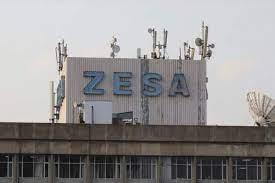News / National
Zimbabwe revels in improved power supply
24 Jul 2025 at 14:12hrs |
22 Views

Zimbabweans are breathing a sigh of relief as the nation celebrates a significant improvement in electricity supply, following a surge in domestic power generation. The development marks a critical turning point in the country's long-struggling energy sector, with authorities reporting record-high output levels and a substantial drop in electricity imports.
Data released by the Zimbabwe National Statistics Agency (ZimStat) and the Zimbabwe Power Company (ZPC) indicates that national power generation peaked at 1 617 megawatts (MW) on Tuesday - the highest recorded in recent years. This increase reflects the results of sustained investment, infrastructure upgrades, and operational reforms in the sector.
According to ZimStat's Index of Electricity Generation (IEG) for the first quarter of 2025, the country's electricity generation index rose to 97.0, up 8.7 percent from 90.2 during the same period last year. The index also recorded a quarter-on-quarter rise of 6.1 percent, up from 91.4 in the fourth quarter of 2024.
The Hwange Thermal Power Station continues to lead national output, contributing 1 674.5 gigawatt-hours (GWh), or 69.2 percent, of total generation in the first quarter. Kariba Power Station produced 24.3 percent of the total, while Independent Power Producers (IPPs) made up the remaining 6.5 percent.
The trend has extended into the second quarter, with ZPC's daily output on Tuesday showing 1 135MW from Hwange, 424MW from Kariba, and 58MW from IPPs - totaling 1 617MW.
In a further sign of progress, Zimbabwe's reliance on imported electricity has dropped sharply. ZimStat reported a 37.4 percent decrease in electricity imports in the first quarter of 2025, down to 305.5GWh from 487.8GWh in the previous quarter. Compared to the same period last year, imports fell by nearly 40 percent.
South African utility Eskom accounted for 34 percent of the imports, while Mozambique's HCB and EDM supplied 37.5 and 10.2 percent, respectively.
Communities and industry leaders have welcomed the changes. Bulawayo United Residents Association chairperson Mr Winos Dube noted a tangible improvement in power availability and reduced load shedding across neighborhoods.
"There has been a definite improvement in power supply," Dube said. "Where I live, we only had a short outage on Sunday, but power was back before 9 PM. Yesterday and today, electricity has been stable. This is a major shift from what we had been experiencing for a long time."
Chairman of the Intensive Energy Users Group (IEUG), Mr Eddie Cross, also praised the increased generation but emphasized the need for continued investment.
"The rise in power supply during the first quarter is significant, and we expect further improvement throughout the year," Cross said. "Kariba Dam levels are at 22 percent, which offers potential for more generation. Private sector investments are beginning to boost national supply, though we still face challenges with base load capacity."
While Zimbabwe's energy crisis is far from over, the current trend offers hope that with the right policies and sustained investments, the country can finally achieve energy stability and support both residential needs and industrial growth.
Data released by the Zimbabwe National Statistics Agency (ZimStat) and the Zimbabwe Power Company (ZPC) indicates that national power generation peaked at 1 617 megawatts (MW) on Tuesday - the highest recorded in recent years. This increase reflects the results of sustained investment, infrastructure upgrades, and operational reforms in the sector.
According to ZimStat's Index of Electricity Generation (IEG) for the first quarter of 2025, the country's electricity generation index rose to 97.0, up 8.7 percent from 90.2 during the same period last year. The index also recorded a quarter-on-quarter rise of 6.1 percent, up from 91.4 in the fourth quarter of 2024.
The Hwange Thermal Power Station continues to lead national output, contributing 1 674.5 gigawatt-hours (GWh), or 69.2 percent, of total generation in the first quarter. Kariba Power Station produced 24.3 percent of the total, while Independent Power Producers (IPPs) made up the remaining 6.5 percent.
The trend has extended into the second quarter, with ZPC's daily output on Tuesday showing 1 135MW from Hwange, 424MW from Kariba, and 58MW from IPPs - totaling 1 617MW.
In a further sign of progress, Zimbabwe's reliance on imported electricity has dropped sharply. ZimStat reported a 37.4 percent decrease in electricity imports in the first quarter of 2025, down to 305.5GWh from 487.8GWh in the previous quarter. Compared to the same period last year, imports fell by nearly 40 percent.
Communities and industry leaders have welcomed the changes. Bulawayo United Residents Association chairperson Mr Winos Dube noted a tangible improvement in power availability and reduced load shedding across neighborhoods.
"There has been a definite improvement in power supply," Dube said. "Where I live, we only had a short outage on Sunday, but power was back before 9 PM. Yesterday and today, electricity has been stable. This is a major shift from what we had been experiencing for a long time."
Chairman of the Intensive Energy Users Group (IEUG), Mr Eddie Cross, also praised the increased generation but emphasized the need for continued investment.
"The rise in power supply during the first quarter is significant, and we expect further improvement throughout the year," Cross said. "Kariba Dam levels are at 22 percent, which offers potential for more generation. Private sector investments are beginning to boost national supply, though we still face challenges with base load capacity."
While Zimbabwe's energy crisis is far from over, the current trend offers hope that with the right policies and sustained investments, the country can finally achieve energy stability and support both residential needs and industrial growth.
Source - the herald
Join the discussion
Loading comments…





























.jpg)

